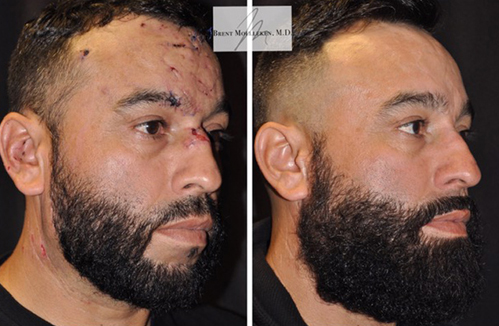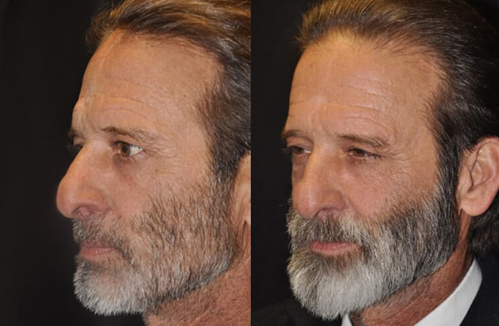Scar Revision
Scars were once a permanent part of life. Whether from traumatic injuries or incisions from surgery, people picked up scars throughout their lives. However, cutting-edge scar revision treatments and medical methods can now remove entire scars from patients.


More intensive scarring may resist complete removal, but treatment reduces their size and visibility significantly. Dr. Brent provides an adaptive approach to scar revision at his Beverly Hills office with a patient-centric philosophy that delivers results and a positive experience.
Each year, more than 100 million people experience scarring as part of a natural healing process. Whether from accidental injury or surgery, the body can only heal wounds or incisions to a certain degree on its own. Lingering scars can lead to being self-conscious and affect your quality of life as a whole. While scarring is natural, with scar revision it need not be as permanent as it once was.
Table of Contents
What Is Scar Revision?
Scar revision treatment plans can remove minor scarring and drastically reduce the visibility of deeper, more substantial scars. When consulting with Dr. Brent, he will be upfront and honest with you about what results you might be able to expect. There are limitations to the procedure, but with his ability and experience, you can be sure that you will receive the highest-quality results.
The procedure can address scars anywhere on the body. The precise nature of these treatments means that you can even address scars in sensitive areas, such as the face and around the eyelids.
Laser Scar Removal
Dr. Brent uses laser technology to speed up your body’s natural recovery. This treatment can also help with raised scars called keloid scars.
Other methods can include moderate chemical peels or resurfacing techniques. These also work well for hyperpigmentation scarring, which occurs when surface scars appear as dark patches on your skin.
The treatment works in one of two ways, depending on the laser type. With ablative lasers, the treatment works by removing the upper layers of the scar. It then encourages the underlying skin to heal in a more natural-looking way. Nonablative lasers work similarly. Instead of removing entire layers, it will create small holes in the scar, which the body then replaces with healthier tissue.
Chemical Peel Scar Removal
Chemical peels might sound daunting, but the options we provide are safe while still delivering results. They are made of acids and enzymes that work toward rejuvenating your skin and treating the scarred tissue. They may require several treatments before you reach your goals.
Chemical peels work by removing upper, damaged layers of the skin and restoring them with new cells. The ingredients in a peel are customized for each patient’s needs, ensuring optimal results with each treatment.
Surgical Subcision
Certain scar types will best respond to surgical subcision, which removes the scar tissue. We typically combine this treatment with other modalities to prevent new scar formation at the surgical site.
Enhancing Your Results
Therapeutic fading cream is often added as a supplementary tool to use at home. These prescribed creams further encourage the skin to replace scar tissue with healthier cells. Even with minor surface scars, it can take time to reach the results you desire. But, with patience and determination, we will help you achieve your goals.
Types of Scarring
Surface Scarring
When a scar is only on the surface of your skin, it can be treated more easily. Acne is perhaps the most common cause of this scarring. Severe breakouts can leave marks on the skin that take years to fade, leading to effects on quality of life. Even minor surface scarring can still dramatically influence how one feels about one’s appearance. We take it seriously and dedicate the same high level of care to all scar types.
Deep Scarring
When scars penetrate down to deeper layers of tissue, there is the chance they cannot be entirely removed. There are still treatment plans available, but they will focus on reducing visibility rather than elimination. As medical techniques continue to develop, though, we continue to provide better and better service in this regard.
Deep scars can result from extreme cases of acne, injury, or surgery. When deep tissue is affected, it can be challenging to treat. However, subcision techniques do exist that can work to minimize the remaining scar. When combined with other treatments, such as laser therapy or chemical peels, they can provide significant improvement.
FAQs
Which scar revision option is right for me?
Size and type of scarring will factor into your treatment plan. During your consultation with Dr. Brent, he will evaluate your target areas. He will discuss with you the options that are most likely to help you reach your goals while also being honest about what your results can be.
The deeper and larger your scarring is, the more likely there will be several treatments combined into your program. Lighter surface scarring is typically more straightforward. Either way, Dr. Brent creates a plan that is specifically for you.
Is there a recovery period after treatment?
For surface revision, you will see results soon and with no downtime. However, some patients may want to take some time away from social engagements to allow any redness to fade. Patients treating multiple scars on the face, such as acne scars, usually will take some time off from work. Since multiple areas are treated, the redness and swelling can be more noticeable. Otherwise, you can resume your daily routine the same day.
What should I do after treatment?
The main focus after treatment is to avoid irritating or damaging the treatment areas. Even minor damage can interfere with proper healing. We recommend patients avoid certain things, such as:
- Excess sun exposure
- Use of abrasive or exfoliant facial products
- Contact sports or other higher-risk recreational activities
- Swimming pools
- Strenuous activity (anything that could lead to sweating)
- Scratching or itching the treatment areas
What will my scar revision results look like?
Most patients will need to complete a regimen of multiple treatments to see full results. The number can vary and depends on the type and severity of the scar. For most patients, a regimen will involve between 2 and 5 sessions.
Results will depend on scar type and severity. Many surface scars respond well to treatment, disappearing entirely. Deeper or more substantial scars still respond well, resulting in dramatic improvements in appearance. However, these scars may not fully vanish. We let you know ahead of time what results to expect.
When will I see the results?
Though the initial healing process is quick, it may take a couple of months before you see the full results. Some cases may take up to a year. But these are treatments that last. Once you’ve completed a scar revision treatment and the results come in full, you’ll see a drastic change in your skin.
During your consultation, Dr. Brent will provide an overview of what your timeline will look like. He takes into account factors like the treatment type and how responsive he expects your scar to be. You should fully know what to expect before you commit to a course of treatment.
Is scar revision painful?
We take every precaution to ensure a comfortable treatment experience for patients. With both laser treatments and surgical subcision, we use local numbing to reduce any discomfort. For laser treatments, you can receive a topical cream that gently numbs the skin. You may still feel some sensation, but it only feels like a rubberband snapping on the skin. With surgical techniques, we use local anesthetic to fully numb the treatment area. You will be awake but will not feel any pain.
You may feel mild discomfort after the treatment as the skin heals. However, even over-the-counter pain relievers can effectively keep this down to a minimum.
How long does the treatment take?
What is the recovery like after scar revision?
Most laser treatments involve minimal recovery. Even for surgical options, scar revision requires virtually no downtime. After laser treatment, the site can be sensitive and swollen. With surgical subcision, it will be much the same. In both cases, simply follow your post-treatment instructions to facilitate healing and avoid damaging the treatment sites. Until the scar site heals, you will need to avoid sun exposure, strenuous exercise, and anything that could irritate the skin (e.g., swimming pools, certain skin products).
How much does scar revision cost?
The cost of scar revision can range dramatically, from a few hundred dollars to over a thousand. The cost depends on several factors, including:
- Experience of the provider (better surgeons produce better results)
- Type of treatment
- Number of treatments needed
- Complexity of the treatment
We will work out a full quote during your consultation so you can see what your treatment costs look like before committing to a plan. We always provide transparent breakdowns of treatment costs so you will face no surprises.
Does insurance cover scar revision?
Insurance companies usually do not provide coverage for scar revision procedures. In some cases, a plan may cover treatment if a scar causes additional symptoms beyond cosmetic ones. For most scars, removal treatments count as cosmetic procedures.
Can scars come back after treatment?
In rarer cases, some scars can grow back after removal. Typically, this only includes some keloid and hypertrophic scars. Since these scars occur due to too much collagen production, they can regrow. Other scar types, like acne scars or other atrophic scars, should heal well and will not return. Dr. Brent will let you know during your consultation what you can expect. If his exam of your scars concludes a possibility they will grow back, he will let you know before moving forward with the procedure. We strive to ensure patients receive full information before they commit to any treatment at our clinic.
What scar types can be improved with treatment?
Dr. Brent adapts his technique to address a range of scar types. We have treatments for both surface scarring and deeper scarring, each delivering impressive results. Scar types we treat include:
- Keloid Scars: Scars that can grow beyond the wound site and are often raised. More common in darker skin tones.
- Hypertrophic Scars: Grow over the wound but remain within its boundaries. Occurs due to overproduction of collagen during healing. Typically red or purple.
- Atrophic Scars: Heal as depressions or indents in the skin. Usual causes include acne, chickenpox, and skin infections.
- Striae: Also called birthmarks, these silvery lines appear in rapidly stretched skin. Like scars from wounds, they usually need treatment to resolve.
- Linear Scars: Straight lines typically from incisions or small cuts. These often form after some surgeries.
Schedule Your Consultation Today
For any questions or to learn more about treatment options, contact the office of Dr. Brent, Plastic Surgeon in Beverly Hills, today to schedule a consultation. He will work with you to provide a personalized scar revision treatment plan.
Don’t let unwanted scarring interfere with your life anymore. We will be by your side every step of the process, providing top-quality care and keeping you informed along the way.


